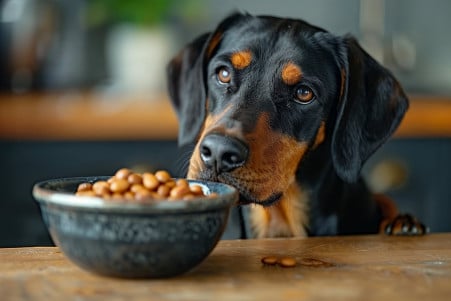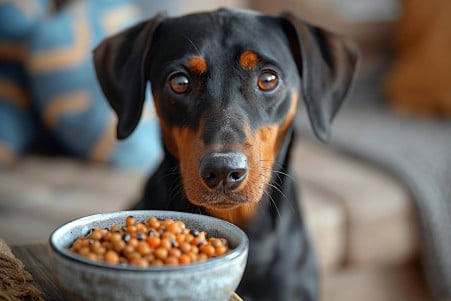Can Dogs Eat Garbanzo Beans? Nutritional Insights and Safe Feeding Tips
20 February 2024 • Updated 19 February 2024

If you’re thinking about giving your dog a plant-based snack, garbanzo beans may be on the list of options. After all, garbanzo beans are safe for dogs to eat and can be a good source of nutrition when given in moderation.
When served as a plain, cooked snack, chickpeas can give dogs protein, fiber, and other important nutrients. However, you should stay away from canned garbanzo beans, which are often high in sodium, and never give your dog raw garbanzo beans.
To better understand whether or not garbanzo beans are a good option for dogs, we’ll take a closer look at the nutritional breakdown of garbanzo beans, listen to advice from veterinarians, and explore research in the field of animal dietetics.
By doing this, we can learn about the potential benefits, risks, and best ways to serve garbanzo beans to dogs. This article aims to provide a well-rounded view of how to safely add this legume to your dog’s diet so that you can make sure your pet reaps the rewards without any negative consequences.
Can dogs eat garbanzo beans?
Nutritional Value of Garbanzo Beans for Dogs
Garbanzo beans, or chickpeas, have a lot of nutritional value that can be good for dogs. According to Healthline, garbanzo beans are high in protein and fiber and are a good source of several vitamins and minerals, including manganese, folate, copper, iron, and zinc. These nutrients are important for a dog’s overall health, as well as for weight control and healthy digestion.
Garbanzo beans are a good choice for dogs with food sensitivities. While it’s important to watch for allergic reactions when introducing any new food to your pet, a study published in PMC found that common food allergens like beef, dairy, chicken, and wheat are not likely to be allergic concerns with garbanzo beans.
In addition, for pet parents who are interested in feeding their dogs a vegetarian or vegan diet, garbanzo beans can be a good source of protein in these plant-based diets. They contain all the essential amino acids and can help ensure that dogs get the nutrients they need without eating animal products.
However, it’s important to work with a veterinarian to make sure the dog’s diet is nutritionally balanced and meets all their dietary needs.
How Garbanzo Beans Impact Your Dog’s Digestive System
One of the most important things to consider when feeding your dog garbanzo beans is how they will impact your dog’s digestive system. Dogs have shorter digestive tracts than humans, which means that they digest food more quickly. This can sometimes lead to digestive upset when introducing new foods, especially those that are high in fiber like garbanzo beans.
A study published in PMC found that using garbanzo beans as the main protein source in dog food had no negative impact on nutrient digestibility or fecal characteristics. The research showed that the diets with garbanzo beans had a high macronutrient apparent total tract digestibility (ATTD), which means that the dogs’ digestive efficiency wasn’t compromised.
In addition, the garbanzo beans didn’t lead to any negative fermentative end-products, which means that they can be added to a dog’s diet without any negative impacts on their gastrointestinal health.
While fiber is important for a healthy digestive system, helping to keep things moving and preventing constipation, it’s still important to introduce garbanzo beans slowly. Doing so will help your dog’s digestive system get used to the higher fiber content and reduce the risk of digestive upset. As with any dietary change, moderation is important for your dog’s overall health and well-being.
Smart Cooking: How to Get the Most Out of Garbanzo Beans for Your Dog
How you cook garbanzo beans can have a big impact on their nutritional content and how easy they are to digest. According to a paper in PMC, cooking methods like boiling, pressure cooking, and microwaving all improve protein digestibility and antioxidant activity in legumes, which is good for your dog.
And since you want to maintain a balance of fiber in your dog’s diet, it’s important to choose a cooking method that maintains the benefits of both soluble and insoluble fiber, as The Farmer’s Dog explains.
To make sure that garbanzo beans are safe and nutritious for your dog, start with dry beans, soak them to reduce anti-nutrients, and then cook them thoroughly without any spices or other ingredients. A study by Hansen et al. in Acta Universitatis Agriculturae et Silviculturae Mendelianae Brunensis in 2023 showed that pressure cooking significantly increased the in vitro digestibility of legumes, which could lead to better nutrient absorption in dogs.
As you add cooked garbanzo beans to your dog’s diet, remember that fiber plays a key role in maintaining healthy digestion, but too much can cause gas and other digestive issues. So, introduce these legumes slowly and in small amounts, and watch how your dog responds so that you can adjust as needed to help them stay healthy.
Portion Control: How to Add Garbanzo Beans to Your Dog’s Diet
If your dog has a sensitive stomach or specific dietary restrictions, you’ll want to be especially careful when adding garbanzo beans to their diet.
In general, you should start with a small amount, like a teaspoon for small dogs and up to a tablespoon for larger dogs, mixed in with their regular food.
A blog post by Spot Pet Insurance notes that you’ll want to make sure you’re not giving your dog too much fiber, as this can lead to problems like loose stool and other gastrointestinal issues. You can then slowly increase the amount over time while keeping an eye on your dog’s reaction.
Rover.com recommends giving your dog garbanzo beans as a treat or mixed in with their regular food. You should always cook the beans with no added salt or seasonings before giving them to your dog. If your dog can’t tolerate garbanzo beans, you can try substituting them with other legumes that are safe for dogs, like green beans or black beans, which also have a lot of nutritional value.
Remember that every dog is different, and what works for one dog may not work for another. You should adjust the amount of garbanzo beans you give your dog based on how they respond to them.
If your dog seems to tolerate garbanzo beans well, they can be a healthy addition to their diet. However, make sure to watch for any signs of discomfort and talk to your vet if you notice any negative reactions.
Navigating Health Risks: Chickpeas in Your Dog’s Diet
Chickpeas can be a good source of fiber and protein for dogs, but there are some health risks to be aware of. While allergies to legumes are rare in dogs, they can occur, and dogs can also experience gastrointestinal issues if legumes are introduced too quickly or in large quantities. Redbarn Pet Products warns that feeding dogs a large amount of beans can cause gastrointestinal upset.
More recently, concern has arisen due to the Food and Drug Administration’s investigation into a potential link between legumes, including chickpeas, and dilated cardiomyopathy in dogs. This investigation highlights the need for more research into the impact of legumes in a dog’s diet.
Dog owners should be on the lookout for signs of an adverse reaction, including vomiting, diarrhea, lethargy, or difficulty breathing, which could be a sign of an allergy or intolerance. Any new symptoms that arise after a change in diet should be taken seriously, and a veterinarian should be consulted immediately.
It is important to consult with a veterinarian before making any significant changes to your dog’s diet, including adding chickpeas, to ensure that they are appropriate for your dog’s specific nutritional needs. This will help ensure that your pet stays healthy while still being able to enjoy a diverse diet.


